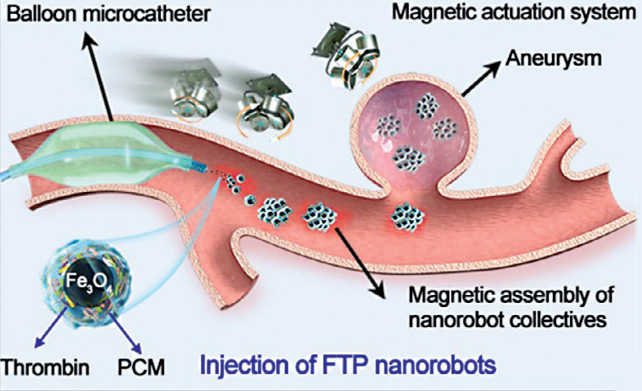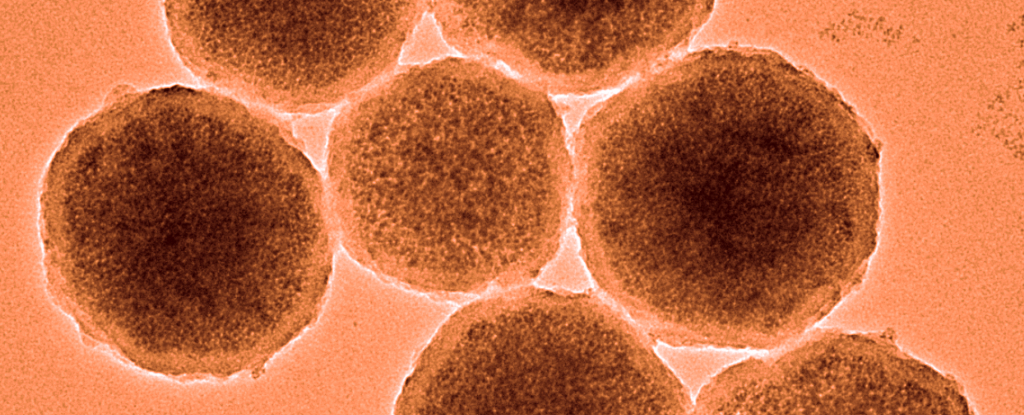Swarms of spherical nanobots barely larger than a virus could one day save hundreds of thousands of lives globally each year by staunching deadly bleeds in the brain.
An international team of researchers, led by clinicians from Shanghai Jiao Tong University and the University of Edinburgh, developed the magnetically-controlled devices to deliver precise doses of clotting agents through a body’s blood vessels to prevent blow-outs.
In a demonstration of their potential effectiveness, billions of the drug-carrying microscopic structures were guided through a test animal’s body to safely defuse a model aneurism in its carotid.
While the technology is yet to be trialed on human patients at risk of a stroke, the team behind the innovation is now confident their design is up to the challenge of delivering controlled amounts of medication to a precise location without losing a drop.
“Nanorobots are set to open new frontiers in medicine – potentially allowing us to carry out surgical repairs with fewer risks than conventional treatments and target drugs with pinpoint accuracy in hard-to-reach parts of the body,” says the study’s co-lead author Qi Zhou, a computational biophysicist from the University of Edinburgh.
“Our study is an important step towards bringing these technologies closer to treating critical medical conditions in a clinical setting.”
A mere 300 nanometers in diameter on average, each individual particle consists of a magnetite core surrounded by a payload of a clotting agent called thrombin, which itself is encapsulated by a protective shell made of a substance that melts at precisely 42.5 degrees Celsius (108.5 degrees Fahrenheit) – just above human body temperature.
Subjected to the twisting forces of a magnetic field under the guidance of a technician, the iron-oxide nucleus drags the nanoparticle through a maze of blood vessels mapped out by ultrasound. Only once the bots are safely within the aneurysm are they subjected to a rapidly alternating magnetic field to melt their coating. This starts the clotting process and prevents the blood vessel from bursting.

The research team put their innovation through its paces in a number of trials testing its effectiveness at clotting, melting points, resistance to degradation, and ultimately its ability to function safely within a body. An injection of nanobots in solution was carried a short distance through the animal’s carotid to a model weakening in the artery wall, where the particles were halted and forced to release their payload on command.
There were no signs of inflammation or inadvertent damage from the heating process, or the drug’s delivery, the researchers found, which bodes well for further testing.
Brain aneurysms affect around 3 percent of people worldwide. Though only a small percentage of these will rupture, the consequences of them spilling their life-giving contents are dire, commonly resulting in debilitation and death in what’s commonly referred to as ischemic stroke.
Caused by a thinning of a blood vessel’s wall, they are commonly prevented from rupturing through surgical procedures that clip or bypass the weakened section, or employ endovascular coiling to block blood flow into the bulging cul-de-sac.
By using nanobots as a form of endovascular plug instead, medical specialists can avoid the potential rejection of clips, or the risks of surgery and bypassing blood vessels.
Additional innovations will be required to ensure the nanobots can move through the depths of the human body, further than the magnetic fields can currently reach.
Yet as far as the proof-of-concept goes, this microscopic paramedic service might one day be the safe and speedy way to prevent a shaky blood vessel from bursting and ending a life.
This research was published in Small.





